对外经济贸易大学:《银行管理学 Bank Management》课程教学资源(授课教案课件)Chapter 10 Evaluating Commercial Loan Requests

對酥竹贸易本孝 1951 Chapter 10 Evaluating Commercial Loan Requests
Chapter 10 Chapter 10 Evaluating Evaluating Commercial Loan Commercial Loan Requests Requests
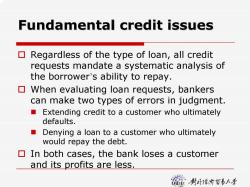
Fundamental credit issues Regardless of the type of loan,all credit requests mandate a systematic analysis of the borrower's ability to repay. When evaluating loan requests,bankers can make two types of errors in judgment. Extending credit to a customer who ultimately defaults. Denying a loan to a customer who ultimately would repay the debt. In both cases,the bank loses a customer and its profits are less. 行贺影小号
Fundamental credit issues Fundamental credit issues Regardless of the type of loan, all credit requests mandate a systematic analysis of the borrower’s ability to repay. When evaluating loan requests, bankers can make two types of errors in judgment. Extending credit to a customer who ultimately defaults. Denying a loan to a customer who ultimately would repay the debt. In both cases, the bank loses a customer and its profits are less
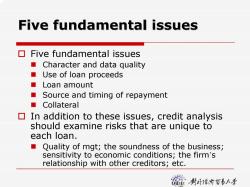
Five fundamental issues Five fundamental issues ■ Character and data quality ■ Use of loan proceeds ■ Loan amount ■ Source and timing of repayment Collateral In addition to these issues,credit analysis should examine risks that are unique to each loan. Quality of mgt;the soundness of the business; sensitivity to economic conditions;the firm's relationship with other creditors;etc. 碰封醉行贸易大孝
Five fundamental issues Five fundamental issues Five fundamental issues Character and data quality Use of loan proceeds Loan amount Source and timing of repayment Collateral In addition to these issues, credit analysis should examine risks that are unique to each loan. Quality of mgt; the soundness of the business; sensitivity to economic conditions; the firm’s relationship with other creditors; etc

Character and quality of data The foremost issue in assessing credit risk is determining a borrower's commitment and ability to repay debts. An individual's honesty,integrity,and work ethic typically evidence commitment.For a business, commitment is evidenced by the owners and senior management. Whenever there is deception or a lack of credibility,a bank should not do business with the borrower. It is often difficult to identify dishonest borrowers. The best indicators are the borrower's financial history and personal references. 的资5土号
Character and quality of Character and quality of data The foremost issue in assessing credit risk is determining a borrower’s commitment and ability to repay debts. An individual’s honesty, integrity, and work ethic typically evidence commitment. For a busines s, commitment is evidenced by the owners and senior management. Whenever there is deception or a lack of credibility, a bank should not do business with the borrower. It is often difficult to identify dishonest borrowers. The best indicators are the borrower’s financial history and personal references
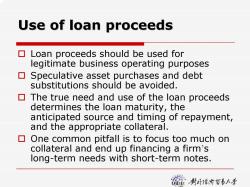
Use of loan proceeds Loan proceeds should be used for legitimate business operating purposes Speculative asset purchases and debt substitutions should be avoided. The true need and use of the loan proceeds determines the loan maturity,the anticipated source and timing of repayment, and the appropriate collateral. One common pitfall is to focus too much on collateral and end up financing a firm's long-term needs with short-term notes. 藏的黄香大孝
Use of loan proceeds Use of loan proceeds Loan proceeds should be used for legitimate business operating purposes Speculative asset purchases and debt substitutions should be avoided. The true need and use of the loan proceeds determines the loan maturity, the anticipated source and timing of repayment, and the appropriate collateral. One common pitfall is to focus too much on collateral and end up financing a firm’s long-term needs with short-term notes

Loan Amount The amount of credit required depends on the use of the proceeds and the availability of internal sources of funds. Borrowers often ask for too little in requesting a loan and return later for more funds. 猫的资6+孝
Loan Amount Loan Amount The amount of credit required depends on the use of the proceeds and the availability of internal sources of funds. Borrowers often ask for too little in requesting a loan and return later for more funds

Primary source and timing of repayment Loans are repaid from cash flows. Four basic sources of cash flows: Liquidation of assets Cash flow from normal operations ■New debt issues ■New equity issues 麓行黄事大考
Primary source and timing of Primary source and timing of repayment repayment Loans are repaid from cash flows. Four basic sources of cash flows: Liquidation of assets Cash flow from normal operations New debt issues New equity issues
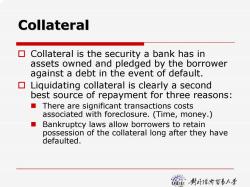
Collateral Collateral is the security a bank has in assets owned and pledged by the borrower against a debt in the event of default. Liquidating collateral is clearly a second best source of repayment for three reasons: There are significant transactions costs associated with foreclosure.(Time,money. Bankruptcy laws allow borrowers to retain possession of the collateral long after they have defaulted. 爸封强的黄香+孝
Collateral Collateral Collateral is the security a bank has in assets owned and pledged by the borrower against a debt in the event of default. Liquidating collateral is clearly a second best source of repayment for three reasons: There are significant transactions costs associated with foreclosure. (Time, money.) Bankruptcy laws allow borrowers to retain possession of the collateral long after they have defaulted

What can be collateral? Virtually any assets,or the general capacity to generate cash flow,can be used as collateral. Collateral must exhibit three features: Its value should always exceed the outstanding principal on a loan. a lender should be able to easily take possession of collateral and have a ready market for sale. 麓封强的黄香+孝
What can be collateral? What can be collateral? Virtually any assets, or the general capacity to generate cash flow, can be used as collateral. Collateral must exhibit three features: Its value should always exceed the outstanding principal on a loan. A lender should be able to easily take possession of collateral and have a ready market for sale
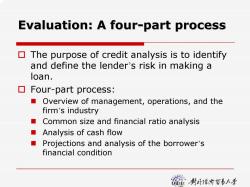
Evaluation:A four-part process The purpose of credit analysis is to identify and define the lender's risk in making a loan. ▣Four-part process: ■ Overview of management,operations,and the firm's industry ■ Common size and financial ratio analysis ■ Analysis of cash flow Projections and analysis of the borrower's financial condition 麓的贫香小手
Evaluation: A four Evaluation: A four -part process part process The purpose of credit analysis is to identify and define the lender’s risk in making a loan. Four-part process: Overview of management, operations, and the firm’s industry Common size and financial ratio analysis Analysis of cash flow Projections and analysis of the borrower’s financial condition
按次数下载不扣除下载券;
注册用户24小时内重复下载只扣除一次;
顺序:VIP每日次数-->可用次数-->下载券;
- 对外经济贸易大学:《银行管理学 Bank Management》课程教学资源(授课教案课件)Chapter 09 Overview of Credit Policy and Loan Characteristics.pdf
- 对外经济贸易大学:《银行管理学 Bank Management》课程教学资源(授课教案课件)Chapter 08 Liquidity Planning and Managing Cash Assets.pdf
- 对外经济贸易大学:《银行管理学 Bank Management》课程教学资源(授课教案课件)Chapter 07 The Effective Use of Capital.pdf
- 对外经济贸易大学:《银行管理学 Bank Management》课程教学资源(授课教案课件)Chapter 06 Managing Liabilities.pdf
- 对外经济贸易大学:《银行管理学 Bank Management》课程教学资源(授课教案课件)Chapter 05 Managing Interest Rate Risk:Duration Gap and Market Value of Equity.pdf
- 对外经济贸易大学:《银行管理学 Bank Management》课程教学资源(授课教案课件)Chapter 04 Managing Interest Rate Risk:Gap and Earnings Sensitivity Sensitivity.pdf
- 对外经济贸易大学:《银行管理学 Bank Management》课程教学资源(授课教案课件)Chapter 03 Managing Noninterest Income and Noninterest Expense.pdf
- 对外经济贸易大学:《银行管理学 Bank Management》课程教学资源(授课教案课件)Chapter 02 Analyzing Bank Performance.pdf
- 对外经济贸易大学:《银行管理学 Bank Management》课程教学资源(授课教案课件)Chapter 01 Fundamental Forces of Change in Banking.pdf
- 对外经济贸易大学:《银行管理学 Bank Management》课程教学资源(试题)期末考试试卷(B卷)答案.pdf
- 对外经济贸易大学:《银行管理学 Bank Management》课程教学资源(试题)期末考试试卷(B卷)试题.pdf
- 对外经济贸易大学:《银行管理学 Bank Management》课程教学资源(试题)期末考试试卷(A卷)答案.pdf
- 对外经济贸易大学:《银行管理学 Bank Management》课程教学资源(试题)期末考试试卷(A卷)试题.pdf
- 对外经济贸易大学:《银行管理学 Bank Management》课程教学资源(作业习题).pdf
- 对外经济贸易大学:《银行管理学 Bank Management》课程教学资源(教学大纲).pdf
- 对外经济贸易大学:《国际运输与物流管理》课程教学课件(授课教案)第十章 国际物流.pdf
- 对外经济贸易大学:《国际运输与物流管理》课程教学课件(授课教案)第八章 采购与供应管理.pdf
- 对外经济贸易大学:《国际运输与物流管理》课程教学课件(授课教案)第九章 分拨管理.pdf
- 对外经济贸易大学:《国际运输与物流管理》课程教学课件(授课教案)第七章 库存管理.pdf
- 对外经济贸易大学:《国际运输与物流管理》课程教学课件(授课教案)第六章 仓储管理.pdf
- 对外经济贸易大学:《银行管理学 Bank Management》课程教学资源(授课教案课件)Chapter 11 Evaluating Consumer Loans.pdf
- 对外经济贸易大学:《银行管理学 Bank Management》课程教学资源(授课教案课件)Chapter 12 Customer Profitability Analysis and Loan Pricing.pdf
- 对外经济贸易大学:《银行管理学 Bank Management》课程教学资源(授课教案课件)Chapter 13 The Investment Portfolio and Policy Guidelines.pdf
- 对外经济贸易大学:《国际商法 International Business Law》课程教学资源(教学大纲,沈四宝).pdf
- 对外经济贸易大学:《国际商法 International Business Law》课程教学资源(作业习题)第一章 绪论(沈四宝).pdf
- 对外经济贸易大学:《国际商法 International Business Law》课程教学资源(作业习题)第二章 代理法.pdf
- 对外经济贸易大学:《国际商法 International Business Law》课程教学资源(作业习题)第三章 合伙企业法.pdf
- 对外经济贸易大学:《国际商法 International Business Law》课程教学资源(作业习题)第五章 外商投资企业法.pdf
- 对外经济贸易大学:《国际商法 International Business Law》课程教学资源(作业习题)第四章 公司法.pdf
- 对外经济贸易大学:《国际商法 International Business Law》课程教学资源(作业习题)第七章 买卖法.pdf
- 对外经济贸易大学:《国际商法 International Business Law》课程教学资源(作业习题)第六章 合同法.pdf
- 对外经济贸易大学:《国际商法 International Business Law》课程教学资源(作业习题)第九章 票据法.pdf
- 对外经济贸易大学:《国际商法 International Business Law》课程教学资源(作业习题)第八章 产品责任法.pdf
- 对外经济贸易大学:《国际商法 International Business Law》课程教学资源(作业习题)第十章 商事仲裁.pdf
- 对外经济贸易大学:《国际商法 International Business Law》课程教学资源(授课教案)第一章 绪论(沈四宝).pdf
- 对外经济贸易大学:《国际商法 International Business Law》课程教学资源(授课教案)第二章 代理法.pdf
- 对外经济贸易大学:《国际商法 International Business Law》课程教学资源(授课教案)第三章 合伙企业法.pdf
- 对外经济贸易大学:《国际商法 International Business Law》课程教学资源(授课教案)第四章 公司法.pdf
- 对外经济贸易大学:《国际商法 International Business Law》课程教学资源(授课教案)第五章 外商投资企业法.pdf
- 对外经济贸易大学:《国际商法 International Business Law》课程教学资源(授课教案)第六章 合同法.pdf
